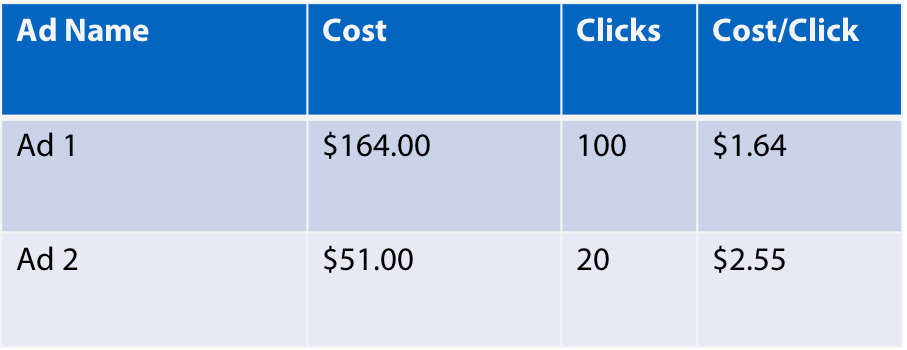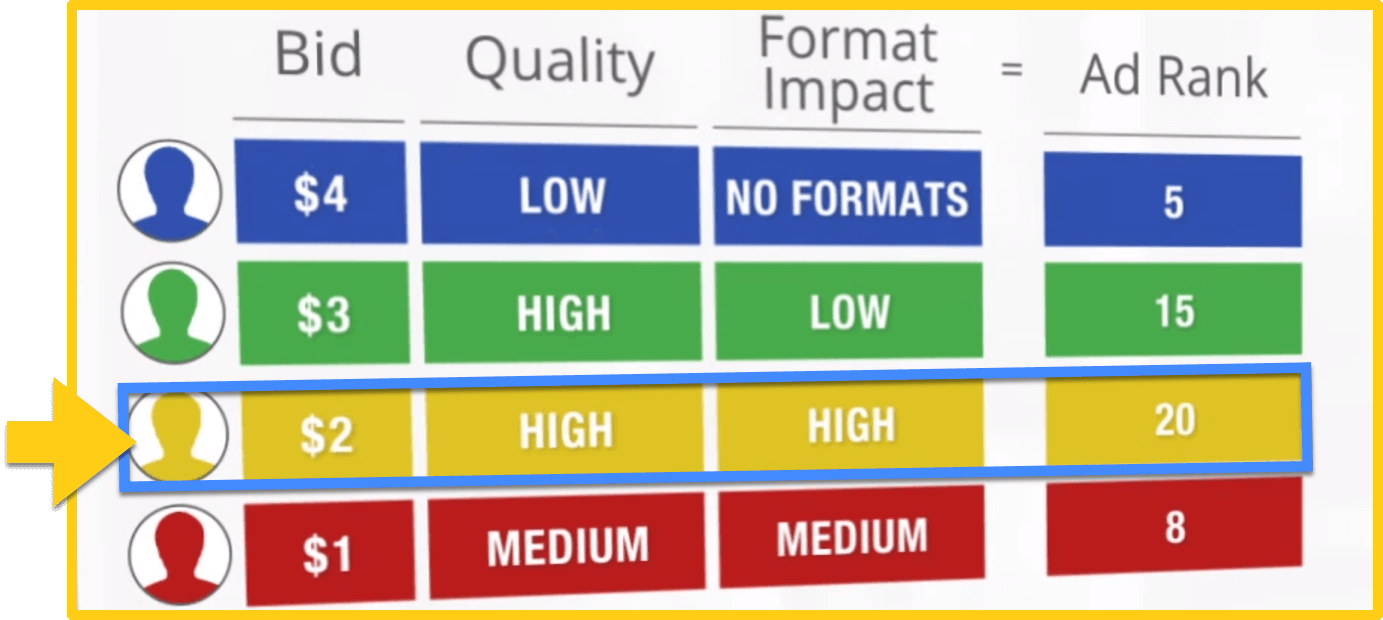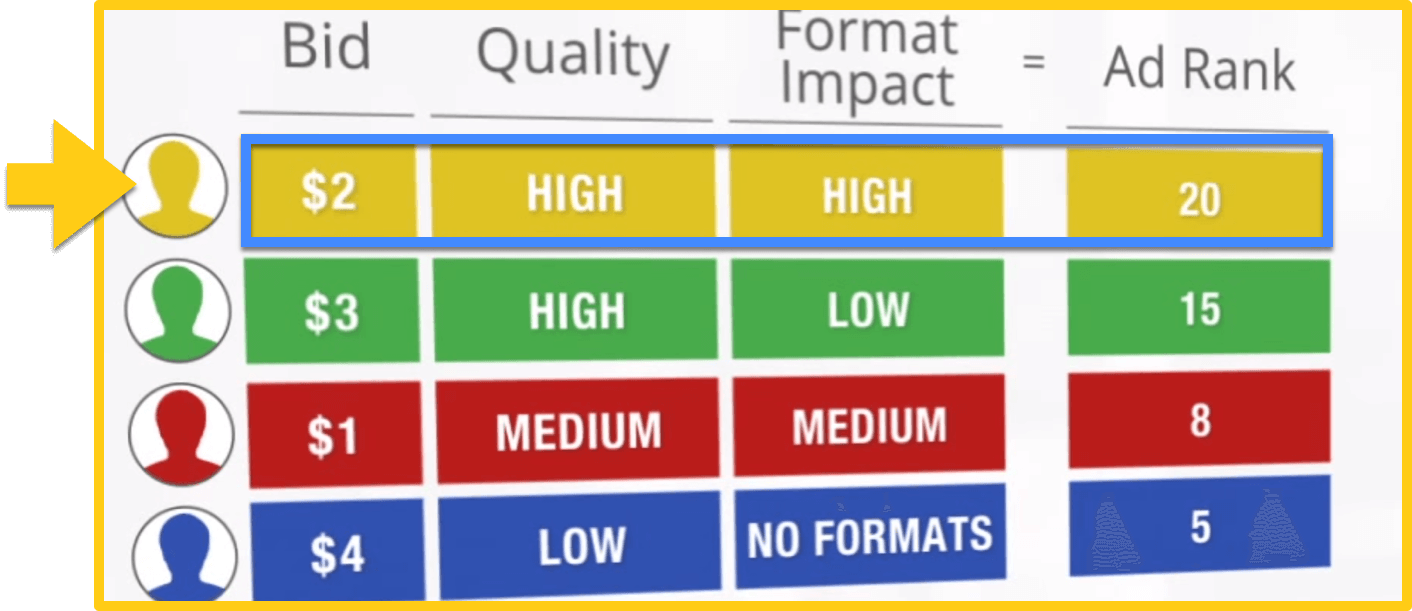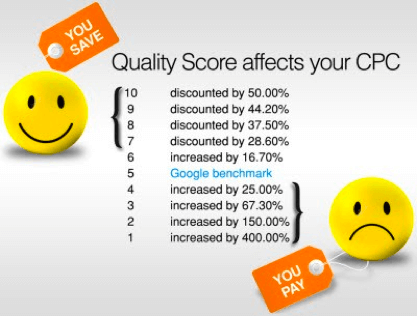A standard AdWords text ad only gives you 140 total characters to deliver a compelling message.
Text space is at a premium. And you want to win clicks right?
Well… Maybe. Keep in mind clicks cost you money.
There are times when you can maximize your budget by not getting nearly as many clicks.
I know this sounds counterintuitive, but it can work.
Sometimes it’s better to qualify your leads by putting your prices in the ad than to entice every searcher to click through on the ad…
On the other hand, losing clicks can hurt your Quality Score, and decrease your Ad Rank.
So what’s the best AdWords copywriting approach? Should you include your price in your text ad?
Let’s look at this question from multiple perspectives. And let’s see how qualifying your clicks on price can affect your advertising.
How AdWords works
We all know that AdWords is a pay-per-click (PPC) advertising platform. But, sometimes it helps to go back PPC basics to work through our decision making.
In search advertising, your ad impressions are free. Impressions don’t cost you anything, so you only pay when someone clicks on your ad.
Of course, I’m not trying to be patronizing with this basic explanation. There is a point here.
You are paying Google for clicks. If you get lots of clicks, advertising can get expensive in a hurry. Often, you will find you get more out of your budget by getting fewer clicks.
A tale of two AdWords copywriting techniques
Let’s look at how this scenario can play out using two different AdWords copywriting approaches.
One approach is intended to drive clicks. The other is meant to qualify clicks.
Example #1 – Hook people with a Free offer
Below is an example of ad and that’s offering a free course. “Free” is a proven copywriting power word. Offering something for “free” creates interest and reduces risk. So when you create a free offer, you’re inviting clicks.

Example #2 – Discourage people from clicking
In this example, we changed our ad copy to display the price. The price is likely to discourage a large part of our audience that would have engaged with our “Free” ad. The result will be a significant decrease in click-through rate (CTR).

Why would we want to decrease CTR? Well, if the goal is to sell a product, paying for every click might not make sense. Our cost per conversion might be lower if we only focus on attracting serious buyers.
Which of these approaches is better? As usual, the answer lies in the numbers.
It’s a numbers game
Let’s work through some hypothetical scenarios to see how they can impact our decision to feature a price in our text ad.
Now, these results are theoretical. They are not from an actual campaign. But these numbers can help us see how qualifying our buyers with a price in our ad can work to your advantage.
In the example below, the advertiser is spending $164 for 100 clicks, equaling a $1.64 cost-per-click (CPC) on Ad #1.
And the advertiser paid $51 for 20 clicks, equaling a $2.55 CPC on Ad #2.

If we look at these results from a pure CPC perspective, Ad #1 is better.

But, when we look at the results in terms of conversions, Ad #2 is the winner.

Ad #2 produced $12.75 cost per conversion, while ad #1 resulted in a $32.90 cost per conversion.

Cost per conversion over CPC
As we’ve discussed before, in previous posts, Google tends to direct us to look at results in terms of CPC. I would encourage you to view your results primarily based on cost per conversion.
There’s only one paid search advertising strategy where CPC is a better indicator of success than cost per conversion. And that strategy is for big brand advertisers working on unlimited budgets.
In our example above, Ad #2 is much more efficient. Even though we lost one conversion, we’re still paying a lot less per conversion.
Get the right clicks
Why is Ad #2 more effective? Because Ad #2 focuses on getting clicks from the right searchers.
Although Ad #2 reduces the number of ad clicks, we get more out of our budget. We gain efficiency by only advertising to people who are in our product’s price bracket.
By putting our price in our text ad, we eliminated 80% of our unwanted clicks. That’s a big cost savings!
Now, we are evaluating using the product price in our ad from a purely theoretical perspective. So, you may still be wondering does this technique really work?
PPC Course Student Question
One of our PPC Course students, Shanan, asks a great question about the practicality of qualifying searchers on price.
If one is selling an expensive product possibly to put the price in the ad. Will this not considerably effect CTR and therefore have a knock-on effect on the ad being shown at the top. Is this not vey likely going to produce a poor result for keyword and ultimately campaign?
He wants to know if reducing clicks will hurt his Quality Score, and in turn hurt his ad campaigns results.
Shanan brings up some critical counterpoints to consider.
And to answer his question – Yes.
If you’re advertising a costly product, displaying your product price in your text ad can reduce wasted clicks.
But, it can also lower Quality Score.
How does reducing clicks affect Quality Score
If your ad is effective at reducing your CTR, it will definitely lower your Quality Score. And decreasing your Quality Score can also lower your Ad Rank.
Bids don’t impact results. Ad Rank Does!
Remember, Ad Rank is based on more than just your bids on your ad’s keywords.

The combination of your bid, your Quality Score, and your ad formats determine your Ad Rank.
Advertisers that use ad extensions and earn high Quality Scores can outrank other ads. Even when they are making lower bids. They can make their dollar more efficient by focusing on Quality Score and utilizing ad formats/extensions.

Fewer clicks results in a lower quality score
Qualifying searchers based on product price almost guarantees a decreased Quality Score.
So, how do we sort this out? We don’t want to waste money on clicks.
But discouraging clicks lowers our Quality Score. And lousy Quality Scores can lower our Ad Rank. Low Ad Rank can drop your our ads out the search results entirley.
There are forces at work in this decision-making process beyond copywriting. Namely, Ad Rank and Quality Score.
We are faced with a catch 22: If you actively try to get fewer clicks, you’ll pay more for click.
Let’s take a look at another set of theoretical results to see how the negative impact on quality score can affect our performance.
This example is the same as the previous results we used (theoretical – NOT based on my real results), but now we’ve included Quality Score.
And we’ve adjusted our CPCs to account for the effect of our quality scores.
In this example, Ad#2, the ad that features our product’s price, still outperforms Ad #1. Ad #2 retained a Quality Score of 8. So, in this scenario discouraging clicks won’t have much impact on Ad Rank.

High quality scores will help ad rank
Here’s a simplified way to think about how quality score impacts your ad bids:
A quality score between 7 and 10 discounts your CPC. Quality scores below a 6 will increase your CPC.

How low can you go?
Let’s look at our example again, and drop the quality score below the discount threshold.
This time Ad #2 has a quality score of 5. But it’s still performing better than Ad #1. Our cost per conversion is about half the price of Ad #1. And our overall cost is down nearly $100.00.
 What happens if our quality score tanks all the way to a 3?
What happens if our quality score tanks all the way to a 3?
 Believe or not, you can still be more profitable discouraging wasted clicks.
Believe or not, you can still be more profitable discouraging wasted clicks.
In our example, you have to hit a quality score of 2 before this strategy becomes ineffective.

This strategy can be very effective at reducing your costs when it works.
But, our results assume you can get rid of 80% of useless clicks just by putting your price in your text ad.
Let’s assume a more modest reduction in wasted clicks from using the price in our text ad.
What happens when we only reduce the number of bad clicks by 20%? This number might be a more realistic outcome. A lot of searchers don’t even really read ads. They just click on the first result they see. And you also have to factor in fraudulent clicks, which usually account for about 1 to 2% of your total volume.
 If including the price in our text only reduces wasted clicks by 20%, then Ad #1 is more efficient.
If including the price in our text only reduces wasted clicks by 20%, then Ad #1 is more efficient.

So putting the price in our text ads could make our ad better or worse.
They are cases where it makes a lot of sense to qualify as many clicks as you can, especially when you’re paying a very high CPC.
But it all comes down to optimizing cost per conversion.
Here are the keys things to remember when using this technique:
- AdWords copywriting can impact your results
- Conduct your own experiments early and often
- Understand how to read your results appropriately
- Determine which test is the winner
- Implement the best performing strategy
- Develop your next experiment
Remember this when it comes to testing AdWords copywriting strategies…
PPC optimization is continuous. That’s what makes it fun!
There’s no end to how many tests you run. And you can always find a way to improve your results.
Ad copy is important, but it’s just one of many tests you can run.
Want to learn more AdWords copywriting strategies? Read our post on the Anatomy of Successful Adwords Text AD, and download our text ad swipe file.
Tell us about your results
Have you experimented with featuring prices in your text ads. How did this strategy work out for you? Did it lower your cost per conversion? Or did it kill your quality scores? Leave a comment below to share your results.
This post and video was episode 58 in our 90 Day Challenge digital marketing series.
To get access to all 90 videos, subscribe to our YouTube channel. YouTube will send our subscribers weekly emails about all the videos we published over the past week.
Want to know about each video and post as soon as it comes out? Sign up for 90 day challenge email newsletter. The newsletter will be the best way to make sure you don’t miss any of the content.
